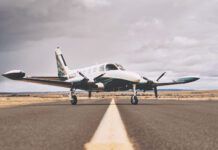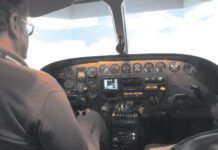Today I’m daydreaming about sneaking into a boardroom where avionics execs are brainstorming the next generation of avionics. The more time I spend with the latest avionics, the more I figure these guys could use some help. Besides, it’s likely there’s free coffee and donuts. Freelance CFI habits die hard.
While they’re talking features and touchscreens and ease of use, I’ll slip an extra chocolate honey-dipped into the pocket of my Goodwill suit and find a seat as far from the PowerPoint as possible. Right about the time the debate begins on whether suppressing text messages on the ILS should be mandatory or optional, I’d clear my throat and tell them they’re going about this all wrong.
Heads would turn. One of the sharp suits would casually swing his cellphone to an ear and whisper, “Security to the Harrison Room, please.” It’ll take them a couple minutes. That’s all I need.
I’d tell them to forget the touchscreens, high-res 3D vistas, and the NEXRAD on approach chart on moving map with three levels of user-adjustable opacity and terrain shading. After sipping the free coffee to build a bit of dynamic tension in the moment, I’d tell them to start with the marketing copy.
Forget about specific features. If you could write the ad for a piece of avionics that truly delivered on the high-tech promise of safety, ease and capability, what would it say? One of my candidates would be, “It’s like having an expert copilot, but you never have to give him a landing.” Or maybe, “Built to make you look smarter than you are.” I could use that one. There are times I’d love to have: “Just fly. We’ve got your back.”
Now: What would that avionics suite look like?
Frankly, we don’t need avionics that do anything more than we’ve had in the cockpit since the second-generation moving-map GPSs. We’ve got enough functions. We’ve got too many functions. What we could use is focus, and someone to help keep track of the details. Good avionics should inhibit mistakes—this aspect could do with improvement, but it’s getting better. Great avionics would catch my mistakes, or even preempt them, before they turn into embarrassments or worse.
Showing me METARs on the moving map: good. Alerting me that my destination just dropped below minimums when I’m still an hour away: great. Offering a nearest airport list: good. Having a voice input button that I can push and say “Nearest!” to have all airports in glide range light up: great.
The big men are closing from both sides of the table, so I’ve got to send this home. I tell them it can be done intelligently. If the localizer needle came alive and this system saw me futzing with an MFD knob, it knows I’m probably not looking at the PFD, so it says, “Localizer alive.” But otherwise its quiet until I’m starting to blow through it. Then it starts to say, “Passing localizer,” unless it sees I’ve started to turn, in which case it holds its cybersmart tongue. That’s unless I’ve turned the wrong way. Again.
By now I’m being escorted along the shortest route to the sidewalk. Over my shoulder, I see stunned faces. But maybe there’s one, just one, giving it a bit more thought. Maybe someone will hit on a way that avionics can catch mistakes the way an instructor does. Maybe they’ll find just the right dose of “less is more.”
And if not, well, I still walk out with the extra donut. —Jeff Van West




